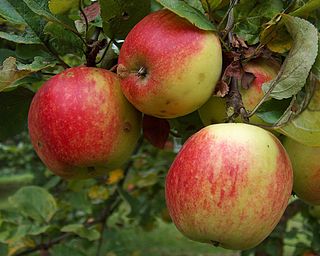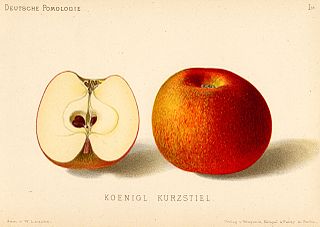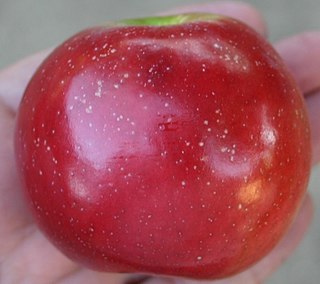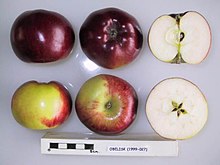
The McIntosh, McIntosh Red, or colloquially the Mac, is an apple cultivar, the national apple of Canada. The fruit has red and green skin, a tart flavour, and tender white flesh, which ripens in late September. In the 20th century, it was the most popular cultivar in Eastern Canada and New England, and is considered an all-purpose apple, suitable both for cooking and eating raw.
Dwarfing is a process in which a breed of animals or cultivar of plants is changed to become significantly smaller than standard members of their species. The effect can be induced through human intervention or non-human processes, and can include genetic, nutritional or hormonal means. Used most specifically, dwarfing includes pathogenic changes in the structure of an organism, in contrast to non-pathogenic proportional reduction in stature.

Cox's Orange Pippin, in Britain often referred to simply as Cox, is an apple cultivar first grown in 1825, at Colnbrook in Buckinghamshire, England, by the retired brewer and horticulturist Richard Cox. Though the parentage of the cultivar is unknown, Ribston Pippin seems a likely candidate. DNA analysis of major apple pedigrees has suggested Margil as the parent of Cox, with Ribston Pippin being another Margil seedling. The variety was introduced for sale by the 1850s by Charles Turner, and grown commercially from the 1860s, particularly in the Vale of Evesham in Worcestershire, and later in Kent. A paper by Howard et al seems to suggest that the Cox Orange Pippin is a hybrid between the Cultivars: Rosemary Russet and Margil based on the SNP data 7

'Pinova' is a German apple cultivar. It was created in 1965 at the Institut für Obstforschung of Dresden–Pillnitz in Saxony which at that time was in the German Democratic Republic. After Germany was re-united in 1990, the rights to the cultivar passed to the Free State of Saxony.

Gala is an apple cultivar with a sweet, mild flavor, a crisp but not hard texture, and a striped or mottled orange or reddish appearance. Originating from New Zealand in the 1930s, similar to most named apples, it is clonally propagated. In 2018, it surpassed Red Delicious as the apple cultivar with the highest production in the United States, according to the US Apple Association. It was the first time in over 50 years that any cultivar was produced more than Red Delicious.

Blenheim Orange (Kempster's Pippin) is a cultivar of apple. It was found at Woodstock, Oxfordshire near Blenheim in England in about 1740. It has been described as a cooking apple.

'Ambrosia' is a cultivar of apple originating in British Columbia, Canada in the early 1990s. The original tree was first cultivated by the Mennell family of Similkameen Valley, British Columbia, who discovered it growing in their orchard.

The 'Spartan' is an apple cultivar developed by R. C Palmer and introduced in 1936 from the Federal Agriculture Research Station in Summerland, British Columbia, now known as the Pacific Agri-Food Research Centre - Summerland. The 'Spartan' is notable for being the first new breed of apple produced from a formal scientific breeding program. The apple was supposed to be a cross between two North American cultivars, the 'McIntosh' and the 'Newtown Pippin', but recently, genetic analysis showed the 'Newtown Pippin' was not one of the parents and its identity remains a mystery. The 'Spartan' apple is considered a good all-purpose apple. The apple is of medium size and has a bright-red blush, but can have background patches of greens and yellows.
Table apples are a group of apple cultivars grown for eating raw as opposed to cooking or cidermaking. Table apples are usually sweet and the most prized exhibit particular aroma variations that differentiate them from other apples. D = Dual purpose

An apple is a round, edible fruit produced by an apple tree. Apple trees are cultivated worldwide and are the most widely grown species in the genus Malus. The tree originated in Central Asia, where its wild ancestor, Malus sieversii, is still found. Apples have been grown for thousands of years in Asia and Europe and were introduced to North America by European colonists. Apples have religious and mythological significance in many cultures, including Norse, Greek, and European Christian tradition.

Golden Noble is an old English cultivar of domesticated apple, which is especially used as a cooking apple, since it is resulting in a sweetish puree when cooked and is a good choice for apple sauce.

'Geheimrat Dr. Oldenburg' is a German apple cultivar. It was created in 1897 at the Höheren Lehranstalt für Obstbau of Geisenheim in the Rheingau, in Hesse in central Germany. It may also be known as 'Geheimrat Doktor Oldenburg', 'Geheimrat Oldenburg', or simply 'Oldenburg'. It is a quite different apple from the older Russian cultivar 'Duchess of Oldenburg', also sometimes known simply as 'Oldenburg'.

'Clivia' is a German apple cultivar. It was created at the Institut für Acker- und Pflanzenbau of Müncheberg, in Märkisch-Oderland in eastern Germany, which at that time was in the German Democratic Republic. It is a hybrid of 'Geheimrat Dr. Oldenburg' and 'Cox's Orange Pippin'. It was reported as a new variety in 1964 and 1965; it was parent of a new cultivar, 'Pinova', in 1965.

The 'Sunset' is an apple cultivar derived from the Cox's Orange Pippin cultivar. Both are found in Great Britain. The fruit has red stripes and an orange flush over a gold background. Usually, part of the apple is red while part of it is yellow. It is similar to 'Cox's Orange Pippin' in that it displays some russetting. The 'Pixie' apple is a distant descendant.
Jubilee apple is a modern cultivar of dessert apple, which was developed in the Canadian province of British Columbia by the Summerland Research Station.

Court Pendu Plat is an extremely old French cultivar of domesticated apple that was first recorded in 1613. The cultivar definitely dates back to earlier than the 17th century, and was probably cultivated by the Romans. It is known for its intense flavor which mellows with storage.

Wijcik McIntosh is a mutation of the McIntosh apple that has a columnar growing habit, meaning that it grows straight and upright, and is spur-bearing, without any major branching. This property is very much appreciated for use as an ornamental plant for itself, and also in the breeding of other apple cultivars, to make them columnar as well.

Melba is a Canadian cultivar of domesticated apple, which was developed by W. T. Macoun at the Central Experimental Farm, in Ottawa, Ontario by crossing a McIntosh with a Liveland Raspberry apple. It has a yellow skin washed with crimson colour. Flesh is extremely white, firm and crisp. Flavor is sweet with hints of tart. There is also a Red Melba mutation which is more red coloured, flesh firmer, and is ripening a few days later in season.

Enterprise is a modern bred, late-ripening and attractive, red cultivar of domesticated apple with excellent fruit quality combined with disease resistance to scab, cedar apple rust, fire blight and some resistance to powdery mildew. The fruit is large and attractive and retains excellent fresh quality for up to six months at 1°C. Its moderate acidity at time of harvest mellows in storage, and it is best after one month of storage.

Splendour, Splendor or Starksplendor is a modern cultivar of domesticated apple which was developed in New Zealand, and is regarded there as a popular commercial dessert apple. It has been said to be a cross between 'Red Dougherty' and 'Golden Delicious', but genetic analysis has not definitely characterized either of the parent cultivars, and records do not indicate known or suspected parents.

















